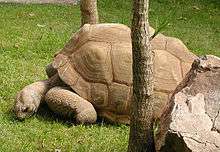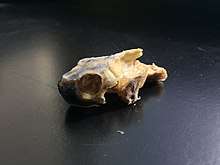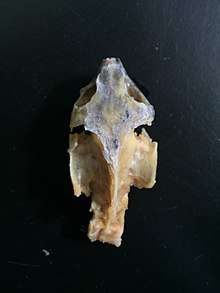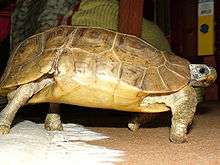Cryptodira
| Cryptodira | |
|---|---|
 | |
| Aldabra giant tortoise (Aldabrachelys gigantea) | |
| Scientific classification | |
| Kingdom: | Animalia |
| Phylum: | Chordata |
| Class: | Reptilia |
| Order: | Testudines |
| Suborder: | Cryptodira Cope, 1868[1] |
| Subgroups | |
| |
| Synonyms[1][2] | |
|
Cryptoderes Duméril and Bibron, 1834
| |


Cryptodira (Greek: hidden neck) is a suborder of Testudines that includes most living tortoises and turtles. Cryptodira differ from Pleurodira (side-neck turtles) in that they lower their necks and pull the heads straight back into the shells, instead of folding their necks sideways along the body under the shells' marginals. They include among their species freshwater turtles, snapping turtles, tortoises, soft-shell turtles, and sea turtles.
Neck Retraction
The Cryptodira are characterized by retraction of the head in the vertical plane, which permits for primarily vertical movements and restricted lateral movements outside of the shell.[3] These motions are largely due to the morphology and arrangement of cervical vertebrae. Of all recent turtles, the cervical column consists of nine joints and eight vertebrae.[4] Compared to the narrow vertebrae and the closely positioned zygapophyses of the pleurodires, the cryptodires’ vertebrae take on the opposite shape. Their cervical vertebrae are more distended, and their zygapophyses (processes that interlock adjacent vertebrae) are much more widely spaced - features allowing for a condition called ginglymoidy, and ultimately, their “hidden” neck retraction. Ginglymoidy refers to the double articulation where articulation between the sixth and seventh vertebrae and the seventh and eighth vertebrae allows for bending of the neck into an S shape. Formation of this S shape occurs in one plane that enables retraction into the shell.[5]
Cryptodiran neck retraction is also dependent on associated cervical musculature for its characteristic motions. In a study that focused solely on the mechanism of neck retraction in Chelodina (Pleurodire) versus that of Apalone (Cryptodire), an absence of the longissimus system, the Iliocostalis system and minimization of the epaxial musculature was found.[4] Absence of longissimus musculature, which primarily functions in moving the neck via ipsilateral flexion and contralateral rotation, contributes to the backwards retraction of the neck into the shell. Lack of this muscular system also results in poorly developed transverse processes (the lateral processes of a vertebra), forcing them to be developed in a more cranial direction. The iliocostalis system, used for lateral flexion and extension of the vertebral column, is commonly absent in all turtles. With the presence of a shell, these muscular movements are no longer possible. Epaxial musculature that functions in alternated forms of stepping and walking is minimized in turtles, due to their restricted stride lengths and heavily weighted shells.[6]
Systematics and evolution
Cryptodires evolved during the Jurassic period, and by the end of the Jurassic had almost completely replaced pleurodires in the lakes and rivers, while beginning to develop land-based species. Meanwhile, pleurodires became the dominant freshwater testudines in the Cretaceous to Eocene of Europe,[7] and produced a family of marine species, the Bothremydidae.
The Cryptodira suborder has three living superfamilies, the Chelonioidea (sea turtles), Testudinoidea (tortoises and pond turtles), and Trionychoidea (soft-shell turtles and relatives). The families within the Kinosternoidea are now recognized as a paraphyletic assemblage of mostly primitive Trionychoidea; they do not form a natural group.
Two circumscriptions of the Cryptodira are commonly found. One is used here; it includes a number of primitive extinct lineages known only from fossils, as well as the Eucryptodira. These are, in turn, made up from some very basal groups, and the Centrocryptodira contain the prehistoric relatives of the living cryptodires, as well as the latter, which are collectively called Polycryptodira.
The alternate concept restricts the use of the term "Cryptodira" to the crown clade (i.e. Polycryptodira). The Cryptodira as understood here are called Cryptodiramorpha in this view.
As per the system used here, the Cryptodira can be classified as:[8]


- †Hangaiemys
- †Paracryptodira
- Family †Baenidae
- Family †Pleurosternidae
- Eucryptodira
- Clade Americhelydia
- †Emarginachelys
- Family Chelydridae (snapping turtles)
- Superfamily Kinosternoidea
- Family Dermatemydidae (river turtles)
- Family Kinosternidae (mud turtles)
- Clade Panchelonioidea
- Family †Sandownidae
- Family †Xinjiangchelyidae
- Family †Sinemydidae
- Family †Toxochelyidae
- †Ctenochelys
- Clade Thalassochelydia
- †Owadowia
- Family †Eurysternidae
- Family †Plesiochelyidae
- Family †Thalassemydidae
- Superfamily Chelonioidea (sea turtles)
- Family †Protostegidae
- Family Cheloniidae (green sea turtles and relatives)
- Family Dermochelyidae (leatherback turtles)
- Superfamily Testudinoidea
- Family †Haichemydidae
- Family †Lindholmemydidae
- Family †Sinochelyidae
- Family Platysternidae (big-headed turtle)
- Family Emydidae (pond, box and water turtles)
- Family Geoemydidae (Asian river turtles, Asian leaf turtles, Asian box turtles and roofed turtles)
- Family Testudinidae (tortoises)
- Clade Pantrionychia
- Clade †Adocusia
- Family †Adocidae
- Family †Nanhsiungchelyidae
- Superfamily Trionychia
- Family Carettochelyidae (pignose turtles)
- Family Trionychidae (softshell turtles)
- Clade †Adocusia
- Clade Americhelydia
References
- 1 2 Rhodin 2011, p. 000.171
- ↑ Rhodin 2008, p. 000.3
- ↑ Anquetin, Jérémy; Tong, Haiyan; Claude, Julien (2017-02-16). "A Jurassic stem pleurodire sheds light on the functional origin of neck retraction in turtles". Scientific Reports. 7: 42376. doi:10.1038/srep42376. PMC 5312562. PMID 28206991.
- 1 2 Biology of turtles. Wyneken, Jeanette, 1956-, Bels, V. L. (Vincent L.), Godfrey, Matthew H. Boca Raton: CRC Press. 2008. ISBN 9780849333392. OCLC 144570900.
- ↑ "ginglymoidy - oi". doi:10.1093/oi/authority.20110803095853268.
- ↑ "Epaxial and hypaxial muscles - an overview | ScienceDirect Topics". www.sciencedirect.com. Retrieved 2018-05-12.
- ↑ Adán Pérez-García, A new turtle confirms the presence of Bothremydidae (Pleurodira) in the Cenozoic of Europe and expands the biostratigraphic range of Foxemydina, The Science of Nature August 2016, 103:50 First online: 04 June 2016
- ↑ Anquetin, J. R. M. (2012). "Reassessment of the phylogenetic interrelationships of basal turtles (Testudinata)". Journal of Systematic Palaeontology. 10: 3. doi:10.1080/14772019.2011.558928.
Further reading
- Baur, George (1890): On the Classification of the Testudinata. Am. Nat. 24(282): 530-536. doi:10.1086/275138 First page image
- Rhodin, Anders G.J.; van Dijk, Peter Paul; Inverson, John B.; Shaffer, H. Bradley; Roger, Bour (2011-12-31). "Turtles of the world, 2011 update: Annotated checklist of taxonomy, synonymy, distribution and conservation status" (PDF). Chelonian Research Monographs. 5. Archived from the original (PDF) on 2012-01-22.
- Rhodin, Anders G.J.; van Dijk, Peter Paul; Parham, James F. (2008-12-08). "Turtles of the world, 2008 checklist" (PDF). Chelonian Research Monographs. 5. Archived (PDF) from the original on 2012-04-23.
| Wikispecies has information related to Cryptodira |